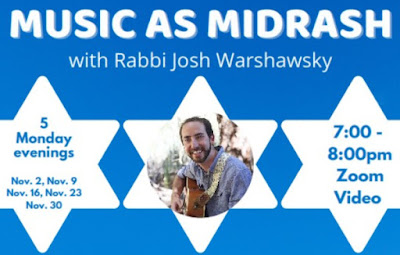Josh Warshawsky & Anat Halevy Hochberg: Music is fundamental to Jewish prayer. So writes Joey Weisenberg, the founder and director of Hadar’s Rising Song Institute, in My Jewish Learning.
Music is the most immaterial and ephemeral of all the art forms.
We can’t see music, we can’t grasp it in our hands, but we can feel it working through us and the world. As such, music represents our connection to the divine, to each other, to everything.
Music is a wordless prayer that opens up our imaginations to the divine source of all life.
 |
| Josh Warshawsky Anat Halevy Hochberg |
Josh Warshawsky is the preeminent voice of contemporary, soulful, exciting music within today’s Judaism. His website tells us
Rabbi Josh Warshawsky is a pray-er, gatherer, music creator, and lifelong meaning-seeker.
He is a nationally touring Jewish musician, songleader, composer, and teacher of Torah. Josh seeks to build intentional praying communities, and travels to synagogues and Jewish communities across the country sharing his music and teachings on prayer.
He has released three albums of Jewish music, filled with melodies written intentionally to express the deep meaning of the words of our tradition.
A few months ago, Rabbi Dov arranged with Josh to teach a class on his approach to composing new liturgical melodies to ancient Jewish prayers. Josh's Music as Midrash class will start on Tuesday November 2.
Click here to learn more.
And click here to listen to a sample of Josh's work.
2. Anat Halevy Hochberg
Anat Halevy Hochberg is a Brooklyn-based musician, writer, educator, and ritualist with family roots in Israel, Yemen, Hungary, and Poland. Her website tells us
Anat Halevy Hochberg grew up playing classical piano and dancing around the living room to the sounds of her parents playing and singing their favorite Israeli tunes.
Anat performs as a solo artist, with her band, Vashti & the NoNoNos, and with other collaborators. Currently, Anat serves as Musician-In-Residence at Yeshivat Hadar in Manhattan.
Anat’s technical training and her professional and communal experience form the vessel through which she is able to share her disarming and empowering joy as a maker of music.
As a Jewish woman of color, a first-generation American whose grandparents survived genocide and displacement, and as a person deeply connected to Israel/Palestine, Anat is continually developing her sense of the heartbreak, complexity, responsibility, and courage that it takes to foster healing in a broken world full of beauty.
As a music teacher in public schools, a leader of song and prayer in Jewish communities, and as a performer, Anat lets everyone in on a secret: that we are all are ready to sing a new song.
Rabbi Dov has invited Anat Halevy Hochberg to co-lead Kabbalat Shabbat with him for the first three Friday evenings of November - the 6th, 13th, and 20th.
Why repeat? To help folks remember new or recently introduced melodies that they can share at services.
Why three repeats? Because three is a chazakah (חזקה)!
Click here to learn more.
And click here to listen to a sample of Anat's work.
3. Yah Ribbon (י-ה ריבון)
יָ-הּ רִבּוֹן עָלַם וְעָלְמַיָּא
G-d, Sovereign of all the Worlds
אַנְתְּ הוּא מַלְכָּא, מֶלֶךְ מַלְכַיָּא
You are the Ruler, above all rulers
Yah Ribon Olam is a piyyut composed by the 16th-century kabbalist poet Rabbi Yisrael Najara. It is one of the most popular Sabbath table hymns (zemirot).
Josh Warshawsky has written:
I learned to sing Zemirot (plural of Zemer) when I was a kid, and immediately fell in love with them. The melodies are beautiful, and the words are poetry. Beautiful hymns and love songs written to Shabbat, or about how we feel on Shabbat, or how we celebrate Shabbat.
Yah Ribon in particular always stuck out to me. You’ll notice immediately that it is different because it is written in Aramaic, the language most Jewish spoke around the time this song was written (16th century).
The words were written by R. Yisrael Najara. In contrast to most of the other Zemirot, which are about Shabbat, the verses of this song mostly talk about different praises of God, and God’s deeds and creations.
But the last verse brings it back to humanity, and to Jerusalem, asking God to return the Divine Presence there, to the place where spirits and souls rejoice, and there we will all sing out songs and melodies.
4. How Can I Keep From Singing?
How Can I Keep From Singing? is an American folksong originally composed as a Christian hymn by American Baptist minister Robert Wadsworth Lowry.
Pete Seeger learned a version of this song from Doris Plenn, a family friend, who had it from her North Carolina family. His version made this song fairly well known in the folk revival of the 1960s.
Seeger's version omits or modifies much of the Christian wording of the original, and adds Plenn's verse below. The reference in the added verse intended by Seeger and by Plenn - both active in left-wing causes - is to 'witch hunts' of the House Un-American Activities Committee.
When tyrants tremble, sick with fear
And hear their death-knell ringing
When friends rejoice both far and near
How can I keep from singing?
In prison cell and dungeon vile
Our thoughts to them are winging
When friends by shame are undefiled
How can I keep from singing?









No comments:
Post a Comment